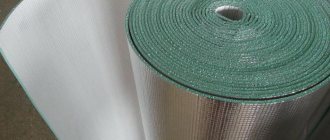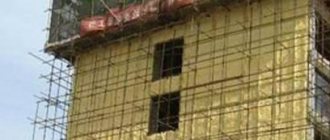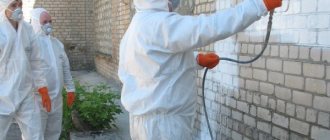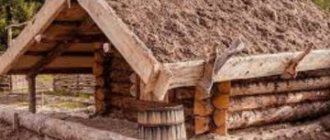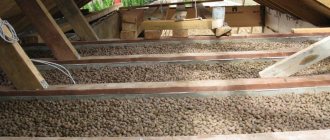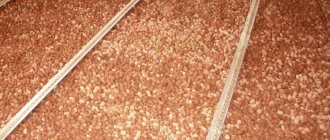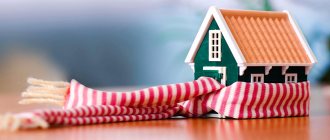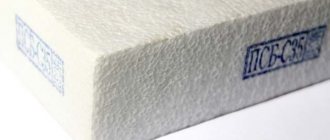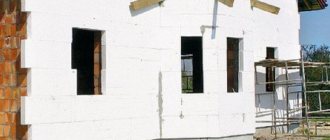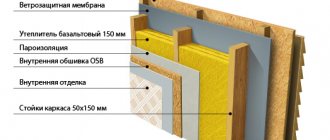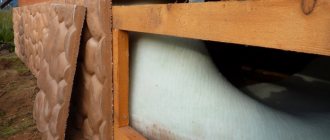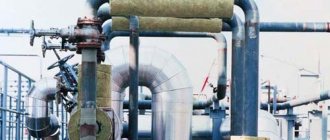What is this technology
The beaches of the Mediterranean Sea are covered with seaweed called Posidonia Oceanica. Previously, this plant was collected and simply disposed of. However, relatively recently it was found that it can do a good job of insulation. As a result of certain treatments, this plant material acquires all the necessary qualities to create an insulating layer.
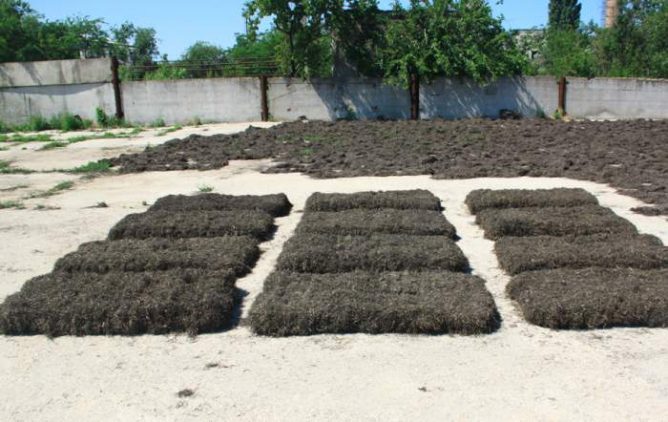
Upon a detailed study of this issue, it was found that a similar technology has been used for several centuries. Residents of coastal areas in warm countries actively dry up seaweed and use it to decorate the roof and walls of houses.
Today, organic raw materials are processed using high-tech equipment. In general, the production methodology is as follows:
- The harvested algae are dried at a certain temperature.
- They are then placed in a special harvester that provides a very intense shaking. As a result, sea sand is separated from the fibers.
- The cleaned raw material goes under the cutting machine, which crushes it into fibers several centimeters long.
- At the end, the raw material is separated into fractions and sent to packaging. Most often, rolls are created by pressing and then tying with strong threads (like glass wool).
Today practically no one makes such heaters on their own, since this is an extremely difficult and burdensome operation. Nevertheless, if you wish, you can implement a similar technology at home, if you have basic equipment.
Key features of natural heat insulators
Further, in the most objective form, the pros and cons of this organic insulator will be considered.
Dignity
This material, to the surprise of many experts, has very useful properties. Adding modern technologies to them, a good insulation was obtained, which has the following list of advantages:
- Absolute environmental friendliness. This is the main "trump card" of such materials. They are completely safe even for children and people suffering from various allergic diseases. Buildings completely finished with such an insulator are breathable, that is, the natural air balance is maintained.
Important! Even when burning, algae do not emit any harmful substances.
- Does not attract rodents and insects. Surely many are familiar with the problem when mice or rats gnaw through a heat insulator (this is especially true for foam). This forces additional protection measures to be applied. Seaweed is not attractive at all. Moreover, due to the high content of iodine, calcium and some other substances, they even scare away such animals.
- Durability. The natural chemical balance ensures a fairly long service life. However, this is typical only under normal conditions, that is, when various layers are organized and no critical temperature amplitudes or high humidity are observed.
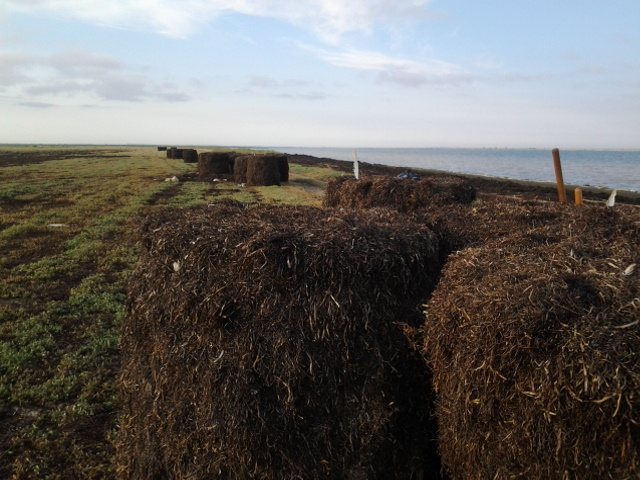

disadvantages
On the websites of manufacturers you can find a lot of information about how effective and practical such heaters are. However, they also have their own serious disadvantages, which in most cases are silent:
- Flammability. Despite the manufacturers' assurances of fire resistance, the dried algae materials burn quite well. Therefore, their use is unjustified from a safety point of view.
- Average thermal conductivity.Such materials belong to class B thermal conductivity (according to Russian GOST). This means that their efficiency is 2-3 times lower than that of "brothers" from class A. Therefore, to create reliable thermal insulation, you will have to increase the thickness of the layer, which is not always justified (especially when it comes to internal insulation, because in this case useful area of premises).
- Poor moisture resistance. In conditions of increased condensation, the thermal insulation will lose its properties, which will reduce its effectiveness. Therefore, it is necessary to create an additional layer of moisture insulation, which is not very rational from an economic point of view.
Stating the above facts, we can state that such a technology is relevant only for regions with a warm climate, because in more severe conditions it will be necessary to create an impressive layer in thickness. She also needs very careful protection from moisture and fire. The use of algae insulation looks reasonable only if the most important criterion for a person is the environmental friendliness of materials. This is true, for example, for people suffering from allergies or respiratory diseases. In all other cases, the use of this ecological insulator is unjustified.
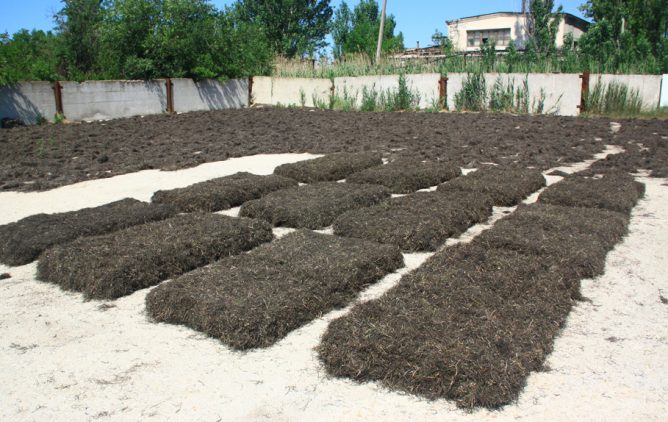

How to identify a truly environmentally friendly material among analogs?
To find the best insulation for your home, you need to rely on the following factors:
- Natural composition. The product must be based on natural components and fibers. It is unacceptable for thermal insulation to release toxins or carcinogens. Even the decorative layer used in the future is not able to protect residents from disease-causing chemical fumes. Any finish will thin out over time, become permeable, coatings and paints are not able to protect against aggressive components.
- Thermal conductivity. Optimal performance is shown by options made from natural fibers, mainly plant ones. When choosing which insulation is the most environmentally friendly, you need to pay attention to the heat transfer coefficient: the ideal interval is 0.032-0.040 W / m ∙ K. This range is sufficient to ensure a healthy indoor climate.
- Moisture resistance. It is necessary to find a sufficiently dense material capable of repelling liquids, since when the fibers get wet, they lose their heat-insulating properties, and the heat transfer coefficient increases. In conditions of excessive humidity, fungi and mold develop, which can cause the spread of pathogenic microorganisms. Natural breathable materials, having absorbed water, dry out with good ventilation and retain all their useful parameters.
- Flammability. This property is especially important in the decoration of buildings, natural raw materials do not contribute to combustion, are vulnerable only when in contact with an open flame and dies out when the latter is localized. Environmentally friendly materials, even when burning, do not produce hazardous toxic substances, in contrast to common names of insulation materials containing formaldehyde (it releases phenols).
The profile market offers a wide variety of safe materials; their characteristics will be considered in more detail below.
Application Tips
Despite their unusual natural origin, algae insulators are installed using the same technology as mineral wool mats. However, there are a few nuances to be aware of.
- For floor and ceiling finishes, it is recommended to use models sold in bales, that is, loose. It is in this form that the insulator has maximum efficiency, since it allows you to fill absolutely all the space, while leaving a layer of air.
- Be careful when cutting the mats. Organic materials are not very strong, so you can only cut along the fibers or next to the threads that run through the entire structure of the mat and ensure its integrity.At the same time, it is extremely undesirable to cut them, since in this case the roll will simply fall apart.
- As mentioned above, when using any organic insulation, a waterproofing layer is required. In this case, the most rational solution is a moisture-proof membrane. It not only provides protection against condensation, but also allows the walls to remain "breathable".
- In areas with severe winters, it is not advisable to use organic matter for outdoor insulation. As a result of the influence of low temperatures, it will begin to collapse.
Moss as insulation
Necessity for invention is cunning! Traditionally, moss - red, sphagnum, cuckoo flax - was used as a mezhventsovy sealant for log cabins ... Moss has a lot of advantages:
EVERYTHING YOU NEED FOR THIS ARTICLE IS HERE >>>
- ecologicaly clean;
- elastic (perfectly fills gaps and cavities of different geometry);
- hygroscopic (absorbs excess moisture and gives it back, while maintaining thermal insulation properties);
- breathable;
- possesses bioactive properties (does not rot).
In addition, it is practically free material. You can buy moss prepared for use, or you can go to the forests and collect it yourself. Mineral wool is definitely not a competitor here.
What algae are used for thermal insulation
For the production of heaters from algae, two types of sea grass are used - sea scum and dwarf scum. They are collected and harvested on the Black Sea coast, while the algae are thoroughly dried. The popular name of this material is damask.
Blackfish (lat.Zostéra marína) is a perennial herb that grows in the coastal waters of warm seas. Its branched root system forms real meadows under water with a lush cover reaching a meter in height. Blossom flowers are pollinated under water, with the help of water streams that carry pollen.
Such unusual and harsh conditions for plant life contributed to the fact that the grass acquired a number of unique biochemical characteristics.
The plant is used in medicine, furniture and food industries. It is used for packaging and filling for mattresses and pillows. In some countries, this algae is used to make roofs similar to thatch. They are lightweight and durable. The leaf width is about 6 mm.
Thermal insulation of the facade with hemp insulation - photo
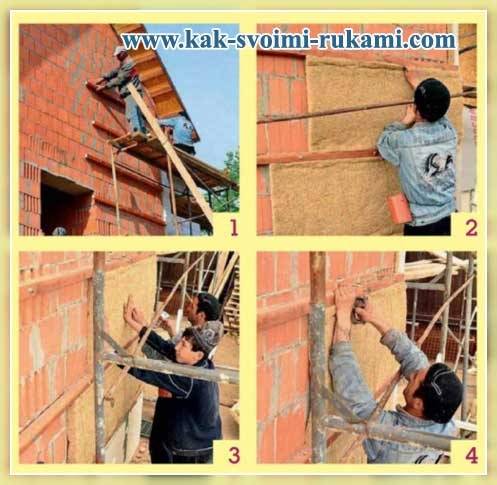

Thermo-Hanf resilient slabs and rolls are 83-87% hemp, 10-12% polyester. They are produced without harmful additives. To increase the fire resistance of the insulation, soda is used. The material is used for heat and sound insulation of walls, roofs and ceilings.
Thermo-Hanf resilient slabs and rolls are 83-87% hemp, 10-12% polyester. They are produced without harmful additives. To increase the fire resistance of the insulation, soda is used. The material is used for heat and sound insulation of walls, roofs and ceilings.
1.On the brick facade of the house, wooden slats are nailed horizontally with a step equal to the width of the greenhouse.
2. Between the slats, the Thermo-Hanf boards are placed in one layer.
H. Small nails are driven into the slats, between which a thin rope is pulled, holding the insulation.
4. After laying the insulation, the facade is sheathed with finishing material.
Reference by topic: What is the best insulation?
The main qualities of the insulation from seaweed ↑
Belonging to the underwater world contributed to the fact that kamka acquired the following properties:
- Environmentally friendly and hypoallergenic. The high iodine content not only saturates the human body with this microelement without the risk of overdose, but also ozonizes and disinfects the air.
- Fire safety. The combustion efficiency of the sea grass is zero.Silicon, contained in it in high doses, makes such algae insulation a non-combustible material, more precisely, hardly flammable. Once on fire, the dried algae will simply collapse without causing the fire to grow.
- Non-toxic. The naturalness of the material excludes the release of poisonous gases and toxic substances during smoldering.
- Durability. Properly harvested damask retains its quality characteristics for 150 years. This is evidenced by the conclusions of Danish experts from the architectural bureau Vandkunsten.
- Practicality. Over time, the material acquires water-repellent properties. Due to the content of tannins, seagrass does not cause rotting or drying out of the elements of the roof that are in contact with it, and is not susceptible to the effects of destructive fungi.
- High thermal conductivity. Algae insulation belongs to the medium thermal conductivity (class B) thermal insulators. This has been proven during tests carried out by the Simferopol Academy of Environmental and Resort Construction at the Department of Chemistry of Building Materials. Subject to a certain level of humidity (16-24%) and density (80-90 kg), the thermal conductivity of the material is 0.087 W. For concrete, for example, this indicator is equal to one, mineral wool has a similar parameter. At the same time, the scum is lighter than both of them.
- Sorption properties. The moisture absorption is about 30%. For comparison, synthetic heat insulators have an indicator of only 0.3 - 0.7%. This is another plus in favor of fire safety. And also proof of the ability to regulate humidity in a room and create an optimal microclimate for humans. It does this by absorbing and then releasing the accumulated liquid in dry air.


Such a natural algae insulation protects the building from drafts and has good sound insulation. Due to its long stay in sea water, it is not exposed to mold.
An added bonus is that the calcium and sodium salts contained in dried algae are excellent at repelling mice and insects. This is especially true for private homes, sheds and cellars.
Sheep wool insulation
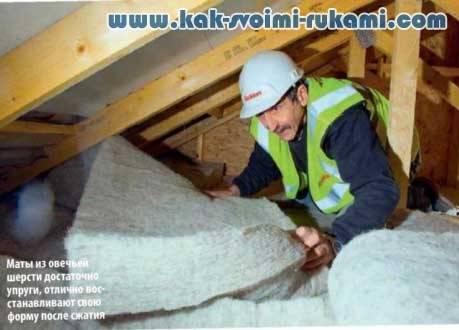

Insulation is also made from sheep wool. Of course, it is not knitted like a sweater. Rather, they roll like felt boots.
For this, mainly the remains of sheep wool production are used, which are treated with insect and rodent protection agents.
Some manufacturers also use fire retardant impregnations, but the bulk of woolen insulation does not have such.
Construction felt
They are produced in the form of rolls, tapes for inter-row sealing and mats of different densities and thicknesses. Among the advantages of the material are low thermal conductivity, elasticity, the ability to absorb a large amount of moisture and, if necessary, release it, regulating the humidity in the house and retaining heat.
TOOL FOR MASTERS AND MASTERS, AND HOUSEHOLD GOODS VERY CHEAP. FREE SHIPPING. THERE ARE REVIEWS.
Below are other entries on the topic "How to do it yourself - a householder!"
- Device for folding clothes with your own hands CONVENIENT DEVICE FOR FOLDING CLOTHES To ...
- Do-it-yourself tiled table - decor Old table decor Many have somewhere ...
- Stable do-it-yourself folding goats for a workshop - photo and drawing Folding goats for a workshop with your own ...
- DIY zipper bracelet (PHOTO + STEP-BY-STEP DESCRIPTION) HOW TO MAKE A BRACELET FROM A REGULAR ...
- DIY night light from LEDs How to make a night light with your own ...
- Compatibility of paints, primers and putties: memo table WHICH FILLERS, PAINTS ARE COMPATIBLE ...
- Stand for vertical storage of tools with your own hands (+ drawings) Vertical storage of tools in the workshop ...
Subscribe to updates in our groups and share.
Let's be friends!
With your own hands ›How to choose or how to make› Encyclopedia of building materials › Natural home insulation
Options and types of thermal insulation materials ↑
Manufacturers offer to purchase sea grass in several forms. Having weighed all the pros and cons, such as the ratio of price, ease of installation and practicality during operation, choose the best option from three possible ones.
Finished heat-insulating plates such as "Fitoizol" or "KamkaS" ↑
The most technologically advanced and easy-to-use form with the price corresponding to the invested labor.
The popular Fitoizol insulation boards on the market are produced by the thermal bonding method, which binds natural and polyester fibers into a single mass. The board consists of 85% prepared algae and 15% organic silicone or casein glue as a binder. Density - 20-50 kg per cubic meter.
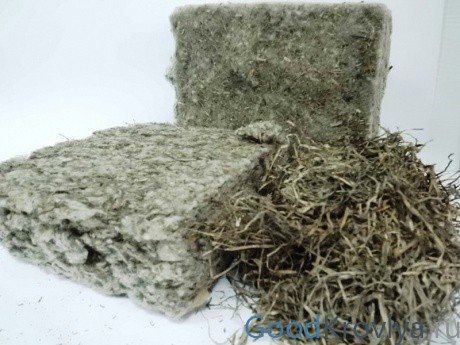

Has the following advantages:
- high performance due to an optimally balanced composition;
- easily cut into pieces of the desired size;
- resistance to weathering and stalling;
- a large selection of slabs of different thicknesses and densities, varying depending on the place of intended installation;
- ease of use: you can choose a ready-made insulation not only for the roof, but also for walls, walls, floors.
Insulation of algae in the form of slabs is suitable for insulating the internal structures of buildings for any purpose. The standard slab size is 1200x600.
Heat-insulating mats in a grid ↑
The option is good, but it requires knowledge to help you make the right choice. Otherwise, you can be disappointed later. A high-quality thermal insulation mat should:
- have a weight of 12-14 kg, with a size of 1000x2000x100, otherwise, you pay for air;
- be well packed, otherwise a half-empty mesh will reach the end user from the manufacturer: weak packing is 20-30% of filling losses during multi-stage loading and unloading operations;
- have cells equal to 80x80, 100x100, 150x150, stitched with high-quality nylon thread.
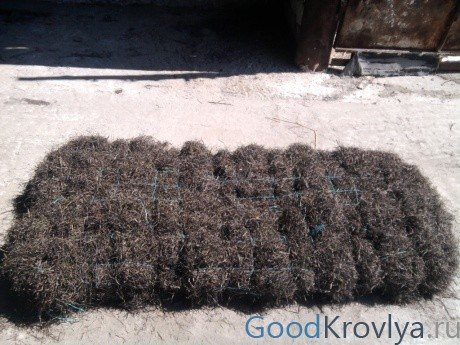

Insulation in mesh mats is a good product, but you should choose it carefully, avoiding dubious manufacturers.
Important! If it is necessary to adjust the size, it is rather difficult to separate such mats. They run the risk of falling apart, so installation will require skill and patience.
Dry seagrass by weight or in bulk ↑
Such algae insulation is produced in pressed rolls or in bales and sold by weight. This is the most budgetary option, which is quite convenient for handling, transportation and storage. The savings of as much as 25% is justified by the fact that the production of this form does not involve the work of knitters, and also does not use threads, as in other options.
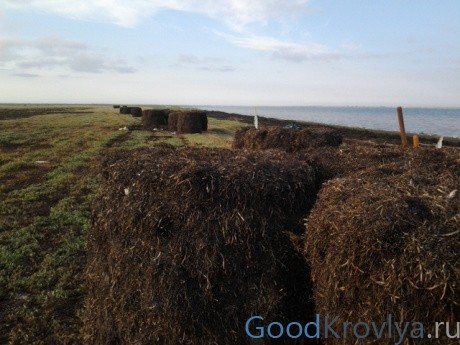

However, they buy loose damask not only for the sake of economy, such insulation can be used in non-standard situations and without thinking about the configuration and size of the insulation area.
An important point during installation is the tightness of the packing. Otherwise, you can get an eco-friendly but cold home.
Features of laying plant thermal insulation ↑
The seagrass, produced in the form of slabs and mats, is selected and installed based on the recommendations of the manufacturers outlined in the instructions. The material is soft and pliable during installation. To lay a damask purchased by weight, you should follow some of the recommendations and tips below.
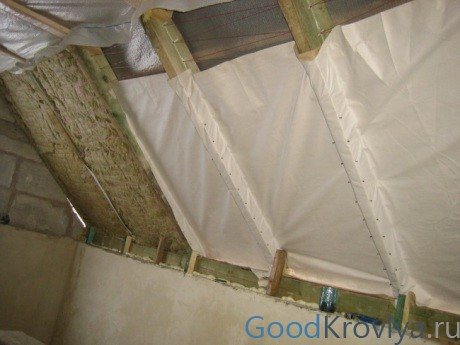

How to calculate the right amount
In order not to be mistaken with the volume of purchased algae for insulation, you can use one of the following methods:
- Method 1.The coefficient of thermal resistance of the part of the building that is planned to be insulated (roof, walls, floor) is calculated in accordance with the region of residence. To do this, it is enough to have basic knowledge in the field of construction, since the calculation itself is simple. After determining the coefficient, it becomes clear which layer the heat insulator will be laid.
- Method 2. If you have difficulty in determining the coefficients, you can use the proven old-fashioned method based on many years of experience. Living in the southern regions can get by with a dam, laid at the rate of 5-6 kg per square meter of roof. For the northern regions, this figure should not be lower than 9 kg per square meter.
Styling secrets or custom sandwich ↑
Roofing is always like a sandwich. By gradually laying out different layers of materials with different properties, a reliable and practical roof is obtained. It should be borne in mind that when using sea grass, the number of layers differs from the standard in a smaller direction, since this building material has the quality of an absorbent.
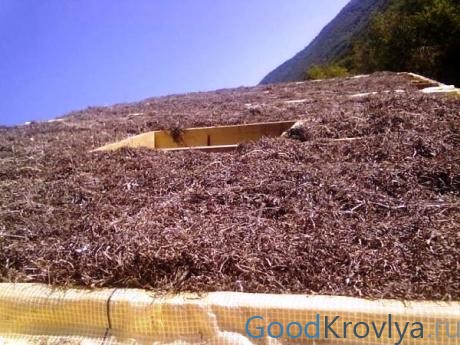

Before laying the insulation, lay a vapor barrier layer. This may be the most inexpensive specialty film. Then the damper itself is mounted, taking into account the required density determined by one of the above methods.
When laying the insulation in bulk, it should be carefully tamped, otherwise it may sag. Particular attention should be paid to the corners and various crevices, which are carefully closed. But to cover such material, imitating a classic sandwich, is impossible. Even with minimal temperature differences, the sorption properties of sea grass will contribute to the creation of the dew point, while at the same time degrading the level of thermal insulation.
Important! Some safety precautions must be observed when laying. The installation standard is the meter distance between the thermal insulation layer and the heating source. This is especially important when building a bathhouse, which is built from dry wood. Here, too, attention is paid to the construction of floors. They must be massive and durable, in no case should they be in direct contact with the damper.
The laid insulation does not tolerate mechanical stress, as it easily breaks, turning into dust. This should be taken into account during possible roof repairs.
Review of manufacturers of heaters made of sea grass ↑
On the market you can find many companies that produce and sell algae insulation. The most famous of them:
- SoTechS LLC, Moscow, Russia, is an exclusive supplier of Zostera algae from the Karkinitsky Bay from the Crimean coast. Sells damask in bales and by weight.
- LLC "Akvafitoresurs", Moscow, Russia, not only sells, but also independently harvests and processes sea grass.
- • LLC "Enterprise of Nonwovens" (PNM), Mytishchi, Moscow region, Russia, produces thermal insulation boards "Fitoizol".
- LLC "Tira", Moscow, Russia, on the basis of a scrubber, produces non-woven volumetric natural insulation Flaxan MIX, which also includes flax and lavsan. The material is produced in mats, size 1050x600x50. According to the conclusions of the Netherlands Institute of Building Biology and Ecology (NIBE), its service life is at least 75 years.
- LLC EKO-term, Ukraine (TM EKO), offers bales or mats, size 1000x600x100 (you can order an individual parameter).
- LLC "EkoKambud", Susanino, Ukraine, produces mats from zostera.
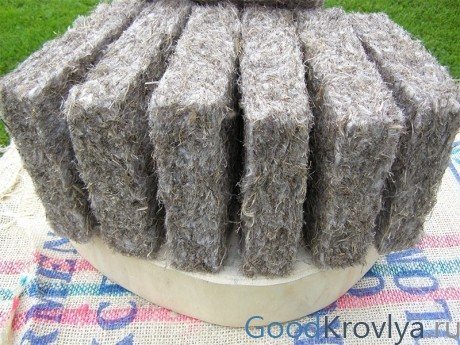

As you can see, there are plenty to choose from. Natural algae insulation has proven itself quite well. If you want to save money, go to the Crimean sea coast to collect zoster with your own hands.If you prefer to use certified products, contact experienced manufacturers who offer not only pure damask, but also its mixtures with various natural materials, such as lavsan and flax.
Eco-friendly frame house from what is built
I am writing to you about insulating your home with natural materials
... I turned to the experience of our grandfathers who used waste or natural materials such as straw, wood shavings, sawdust, chopped hay, reeds, dry oak leaves, waste wool, flax, buckwheat husks, etc.
All these are natural heaters, environmentally friendly, vapor-permeable, besides, they are not expensive at all in comparison with heaters offered in the construction markets. Natural materials are crushed, dried and poured into the formwork of the rough facade or into the ceilings, making sure that they are completely dry.
Moreover, if you exclude the possibility of moisture penetration to it, such a heater serves for an almost unlimited period.
There is another way of warming, when natural materials are crushed, moistened and mixed with a binder material - gypsum, clay, lime. Drying, such insulation becomes non-flammable, is not damaged by rodents and bugs, does not shrink, it is vapor-permeable, does not rot, since the binder acts as a preservative.
If you use a dry backfill, then there are also techniques in which you can ensure its incombustibility, scare off rodents, minimize shrinkage and the possibility of decay.
Insulation from "KAMKA" - myth or reality ?!
Seagrass is a resource whose use makes it possible to intensify industry and agriculture.
Sea herbs have a wide range of applications. They are considered a potential source of raw materials for the creation of food additives, are used in the production of medicines and serve as animal feed (mainly in foreign countries). Livestock eat both fresh and dried seaweed.
In addition, they are widely used for technical purposes as packaging, padding and sound-proofing material, resistant to fire and mechanical damage. Speaking about them, we mean the genus Zoster or Vzmornik (Kamka).
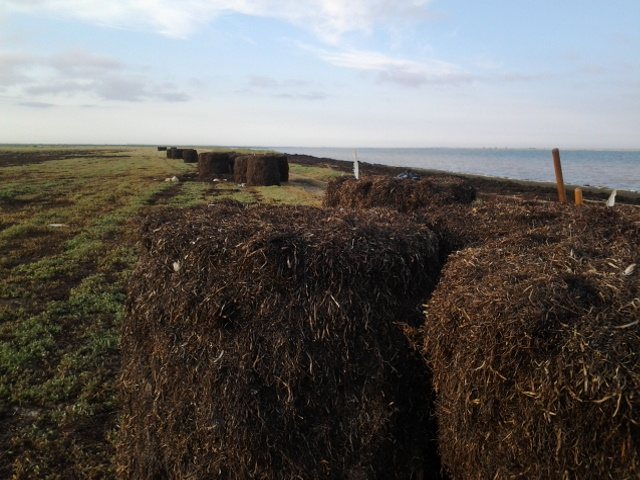

Blackjack. Distribution area
Even in ancient times, mattresses and upholstered furniture, as well as other household items, were stuffed with leaves of a gruel, used as packaging material. Leaves and shoots of zostera, which were carried to the shores by the generous sea, were used as fertilizer for the fields. And the Mexican Indians easily consumed damask in the form of flour.
Kamka belongs to the highest flowering plants that are rarely found in the seas and oceans (their list does not exceed two dozen). During the flowering period, the seagrass is covered with well-aimed white flowers.
Zostera with narrow ribbon leaves grows on sandy soil at a depth of 1-3 meters.
Skamorn is a perennial creeping plant with a flattened rhizome and the same stems, on which leaves are arranged in two rows. Zostera grows in calm waters of bays of different seas (Black, Japanese, Azov). On its meadows fish and sea animals graze, and sometimes even migratory birds.
Physical and chemical properties of Zostera
Hundreds of thousands of tons of sea grasses are washed ashore every year. Only 1% of this amount is used for production purposes. Seafood mainly consists of 2 types of zostera, which shed their leaves in August-September.
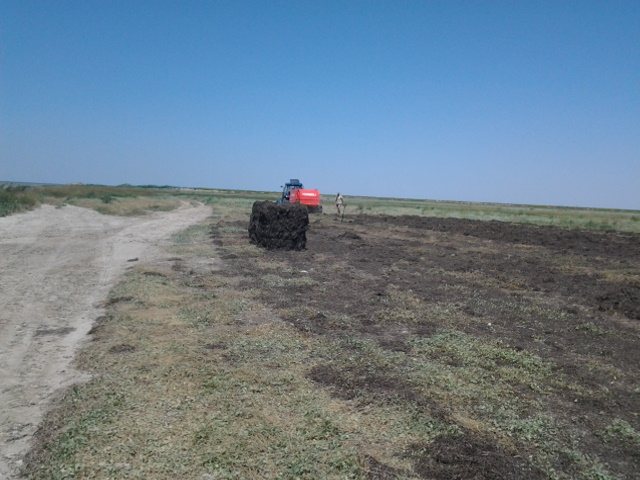

The chemical composition of sea grass is studied in detail in research institutes. Through the efforts of scientists, we learned that zostera contains extractive and nitrogen-containing substances, carbohydrates, minerals and lignin.
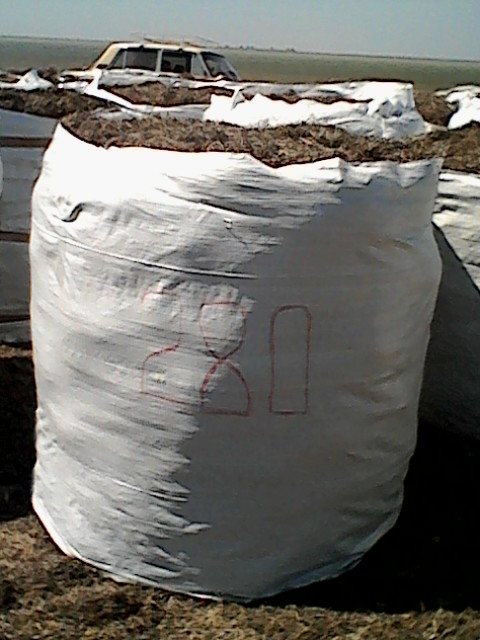

Like other marine plants, zostera is characterized by high ash content, because it accumulates large amounts of minerals.In kamka (as the common people call the herb zoster), micro- and macroelements are combined in optimal proportions. Zostera contains carotene, ascorbic acid and many B vitamins. The high content of iron, calcium, copper and cobalt, the presence of zinc and molybdenum in the composition make kamka an irreplaceable food product for animals.
Zosters in industry
Kamka turned out to be a very promising raw material, and its painstaking study ended with the development of a number of technological processes that led to the creation of means of mechanization and automation of the collection and processing of plants for the subsequent creation of industrial goods. After that, the first children's mattresses with damask filling and new modern heaters appeared. The Moscow Research Institute presented samples of thermal insulation boards for finishing, which became another argument in favor of using Zostera as a raw material in the production of building materials.
At one time, paper was made from damask, and now pectin is extracted from it, which is actively used to obtain marmalade, marshmallows and other gelled products. A large amount of pectins and hemicelluloses allows the Zoster to be used for briquetting and granulating compound feed (as a binder).
Zostera in construction
In Denmark, on the island of Lesso, algae houses have been standing for two centuries. Surprisingly, for the Danes, kamka turned out to be an ideal substitute for wood. It was easy to collect and dry - nature became a reliable supplier of raw materials. And now, centuries later, we can confidently assert that the Danes made the right choice. It is unlikely that we would have seen their creations if the inhabitants of the island used ordinary wood as decoration.
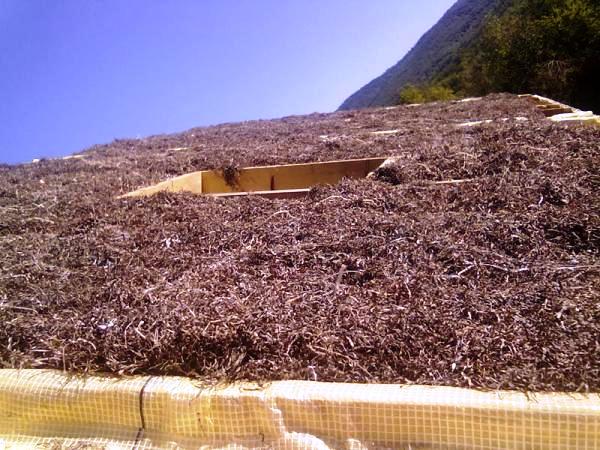

Zostera is the perfect insulation. It is not subject to decay, does not breed mold, pests are afraid of it. Sea grass improves the microclimate and perfectly neutralizes pollution. Over time, the filler becomes even denser and becomes water-repellent. The thermal insulation qualities of kamka are comparable to those of mineral wool.
In modern homes, seaweed is a wonderful filling for timber frames. Zosteroi insulate the roof and floor. If you lay mattresses stuffed with dry algae under the roof, you can “kill two birds with one stone”: insulate the building and create excellent sound insulation. The positive qualities of kamka as a building material (according to experts) remain unchanged for at least 150 years.
Benefits of seaweed insulation
Insulation made from zostera, which grows at the bottom of the seas, is often a stitching mat. It mainly consists of leaves mixed with a small number of stems, which are 20-100 centimeters long. Kamka is tinted brown-green and smells like the sea. It soothes the nervous system and does not lose its beneficial properties even when wet.
Insulation made of sea grass is used for:
A high level of sorption humidification helps to maintain the air humidity that is favorable for humans. In addition, damask contains a large amount of iodine, which saturates the air. As you know, this element has a beneficial effect on the functioning of the thyroid gland.
Review of eco-friendly heaters
Environmentally friendly heaters can be recognized by their natural composition, the most in demand are ecowool, eco-heating, damask, hemp, cotton, eco-therm, ekolen, cork, pressed peat.
Ecoterm
The material is made of linen with 30% addition of bicomponent polyester in the form of a fiber. This additive provides the raw materials with the required level of elasticity and strength. Plates perfectly retain their original appearance, they are conveniently placed between logs and beams, since there is no need for additional fasteners. Pros of eco-thermal:
- the service life reaches 60 years;
- safety and hypoallergenic;
- no electrostatic effect;
- antiseptic properties, self-cleaning ability, resistance to parasites;
- a special structure helps to regulate heat exchange, remove excess moisture.
The characteristics of the fiber largely correspond to wood; such thermal insulation, even in a frame structure, brings the structure closer to the comfort of a wooden house. Linen does not burn, its fire safety is comparable to basalt wool, it provides excellent sound insulation.
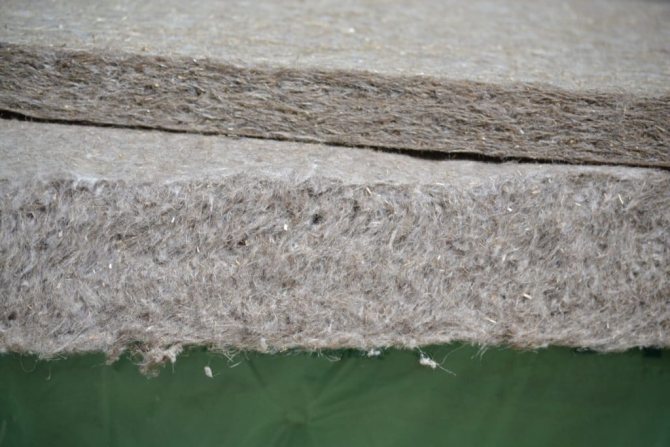

Ecoterm
Ecolin
The material is 85% linen fibers, additives in the form of thermal bonding components allow the raw material to retain its volume. Due to the fact that ecolen does not lose its shape during use, it is actively used to isolate surfaces with a non-standard configuration.
This solution is produced in the form of mats, the thickness of which can be 10 or 5 cm. The optimal heat transfer coefficient and a service life of up to 75 years are the main advantages of the option, it also attracts with breathable properties, so that moisture does not accumulate on the walls.
Bung
Here, the bark from the trunks and branches of a cork tree is laid in the basis, the raw material has a pronounced porous structure. The inner layers of the material contain natural glue, which is beneficial for insulation purposes, the presence of wax prevents water from absorbing.
Natural cork can be recognized by its elasticity and resilience, it is poorly flammable, does not burn without contact with an open flame, even during the smoldering process, toxic vapors are not formed.
Cork insulation is supplied in rolls, plates and slabs with a thickness of 1-50 mm.
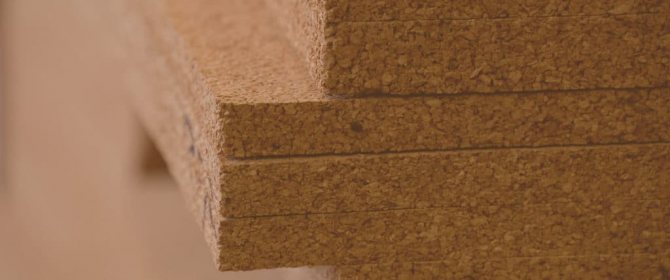

Bung
Peat blocks
The grated peat is combined with water and filler - shavings, sawdust, straw, flax, hemp, the mass is processed and dried, achieving its complete hardening. Blocks are used in the assembly of floors, walls, ceilings. Cons - high flammability and vulnerability to moisture.
Ecowool
In addition to cellulose fiber, it contains antiseptics and fire retardants. The product does not need to be cut, the dry mix is easily distributed in a given quantity. A monolithic layer is formed without seams and joints, which are potential bridges of cold.
Ecowool can be placed manually, mechanized wet and dry. In the first case, volume is added to the mass using a mixer nozzle - it is fluffed up, then it is manually stuffed into niches and cavities. Cellulose fiber can be blown with a gun or compressor - this is a dry method, wet laying involves pre-wetting with an aqueous or adhesive solution.
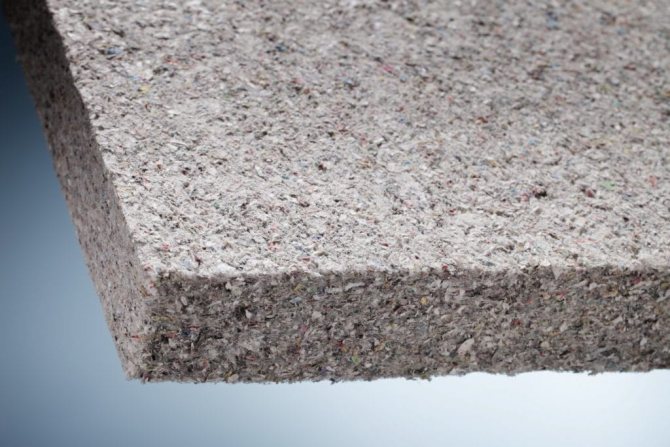

Ecowool
Ecoteplin
Another form of linen material, it does not have auxiliary synthetic additives: starch is responsible for binding, borax serves as a fire retardant. The capillary structure contributes to the rapid absorption of moisture, the product dries quickly, so it is in demand in the construction of steam rooms and saunas, and is indispensable for insulation in the private sector. Ecoteplin exhibits high sound insulating properties.
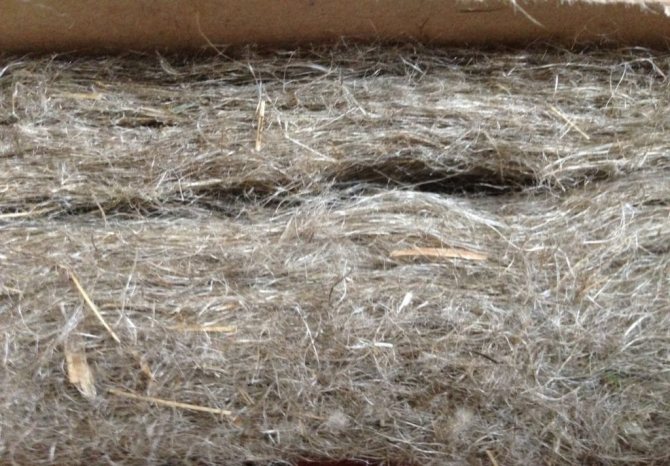

Ecoteplin
Damask
Consists of seaweed that is not afraid of rotting. This raw material is not of interest to rodents, microorganisms do not multiply in it. The fibrous solution is of medium hardness and does not support combustion without an open flame. Distinctive features - high rates of thermal conductivity and packing density.
The form of release is stitched mats 10 cm thick and 100x200 cm in size, they are successfully used for thermal insulation of ceilings and roofs, floors and walls in the residential sector.
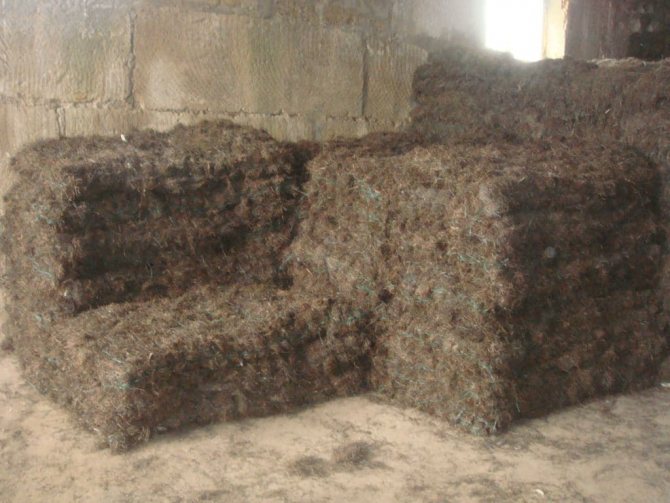

Damask
Hemp
Natural antiseptic properties protect hemp raw materials from mold and mildew damage, which has a good effect on the integrity of the supporting structures. The variant is adapted for use in high humidity conditions. The material is 70% woody plant stems, has a cellulose base, and is devoid of synthetic additives.
Cotton
Cotton mats are considered the safest option from the point of view of the composition of the insulation, they are usually supplied rolled into rolls, recycled fabric is used for production. About 15% of the composition is taken up by thermal bonding fibers.
The standard size of the mats is 100x60 cm, the thickness varies within 2-5 cm, the density range is 45-80 kg / m³. Cotton exhibits high sound insulation, retains heat on a par with basalt wool.
The specific performance properties contribute to the proliferation of cotton mats as a convenient insulation material for home theater installations. All work can be organized independently, since the raw material does not contain dubious components and is supplied in a molded form, you can do without personal protective equipment.

